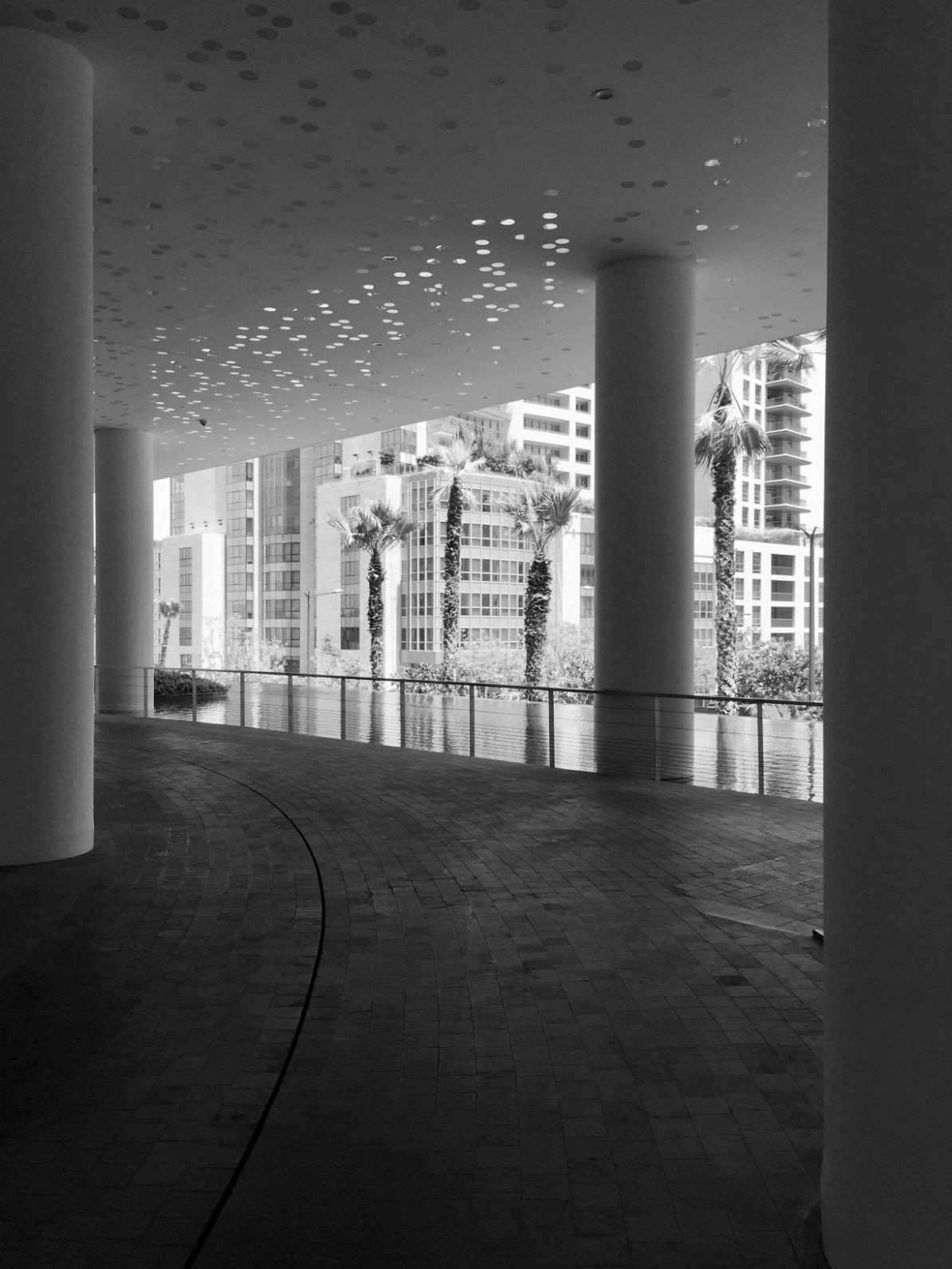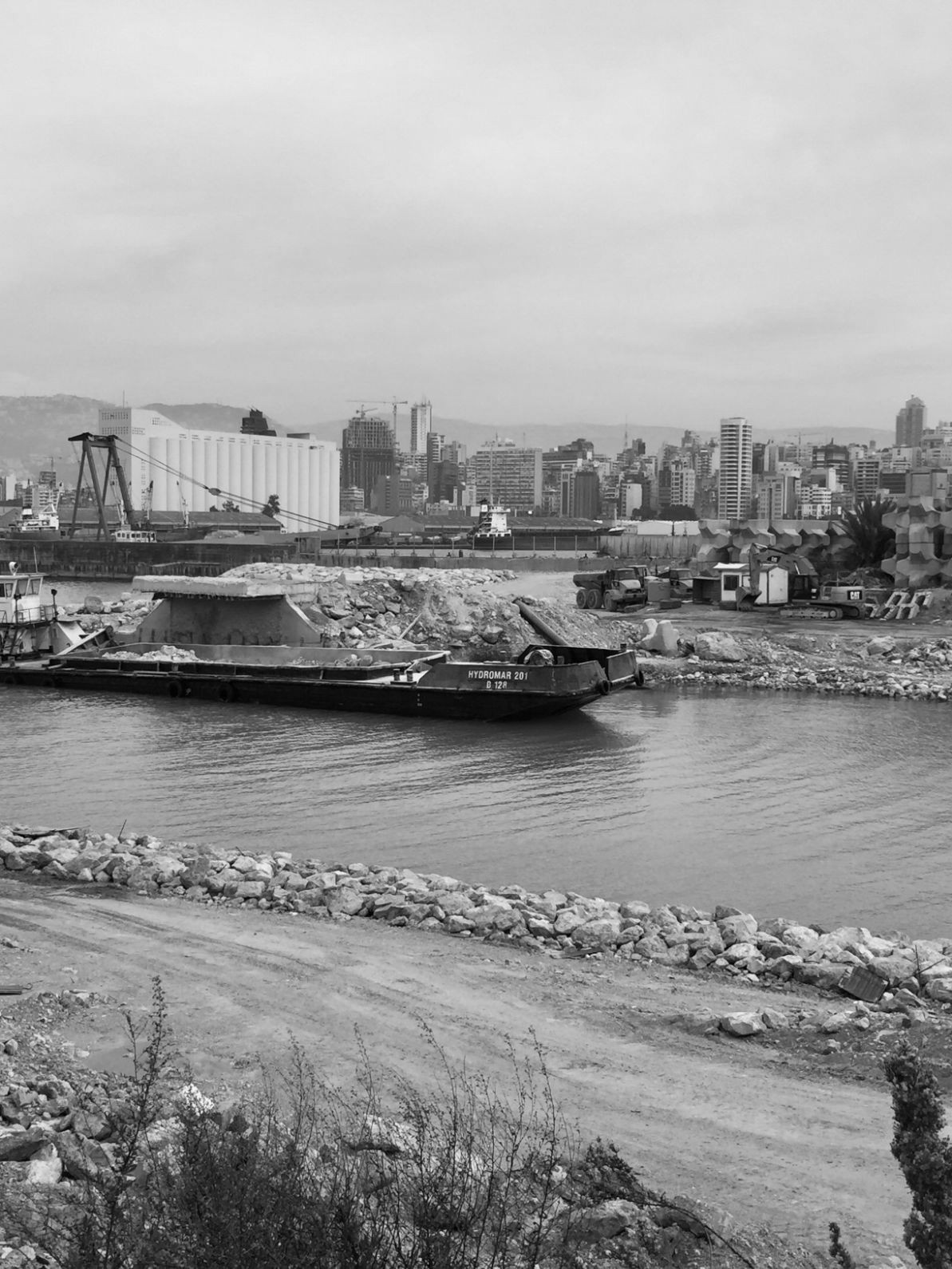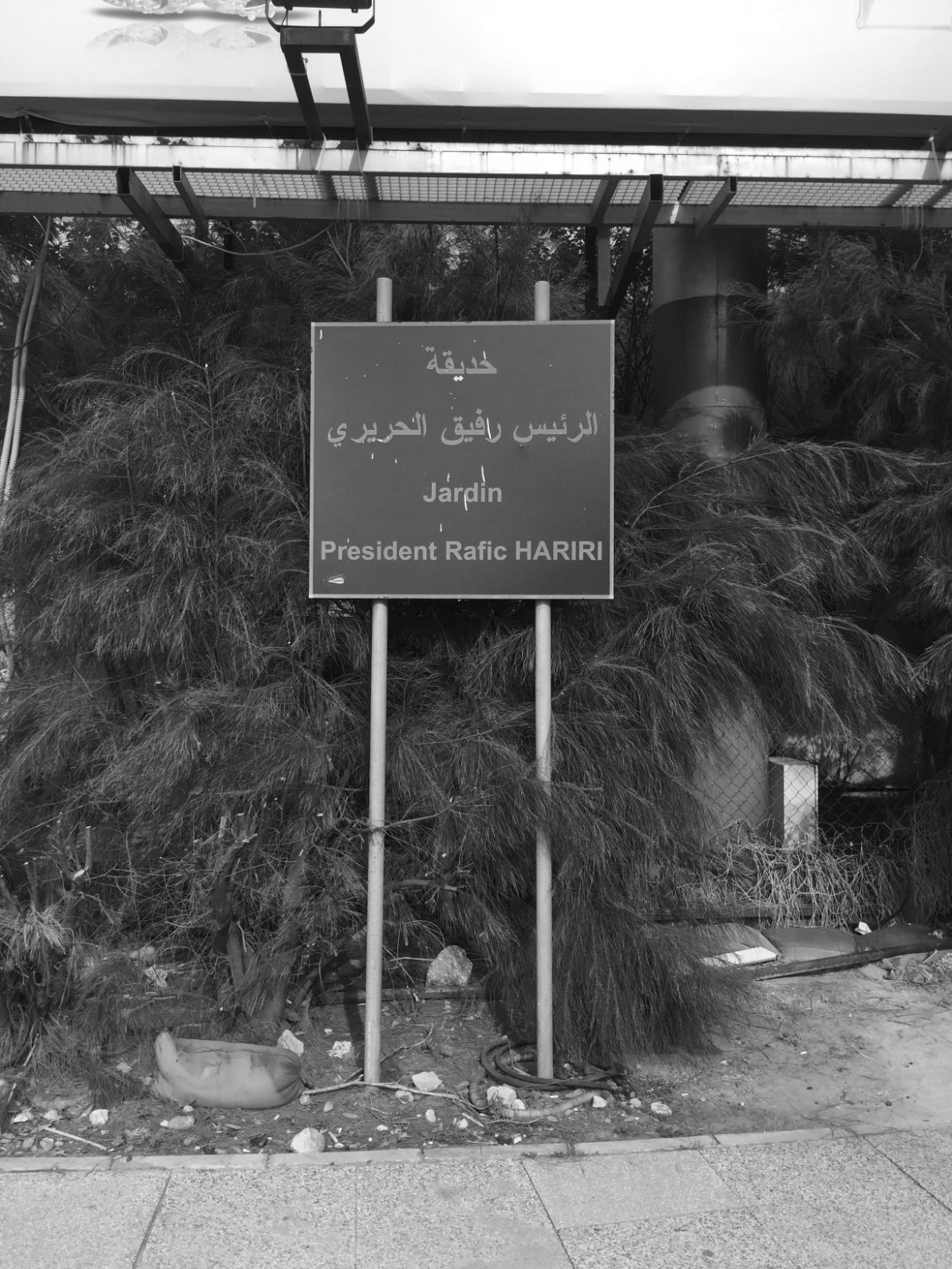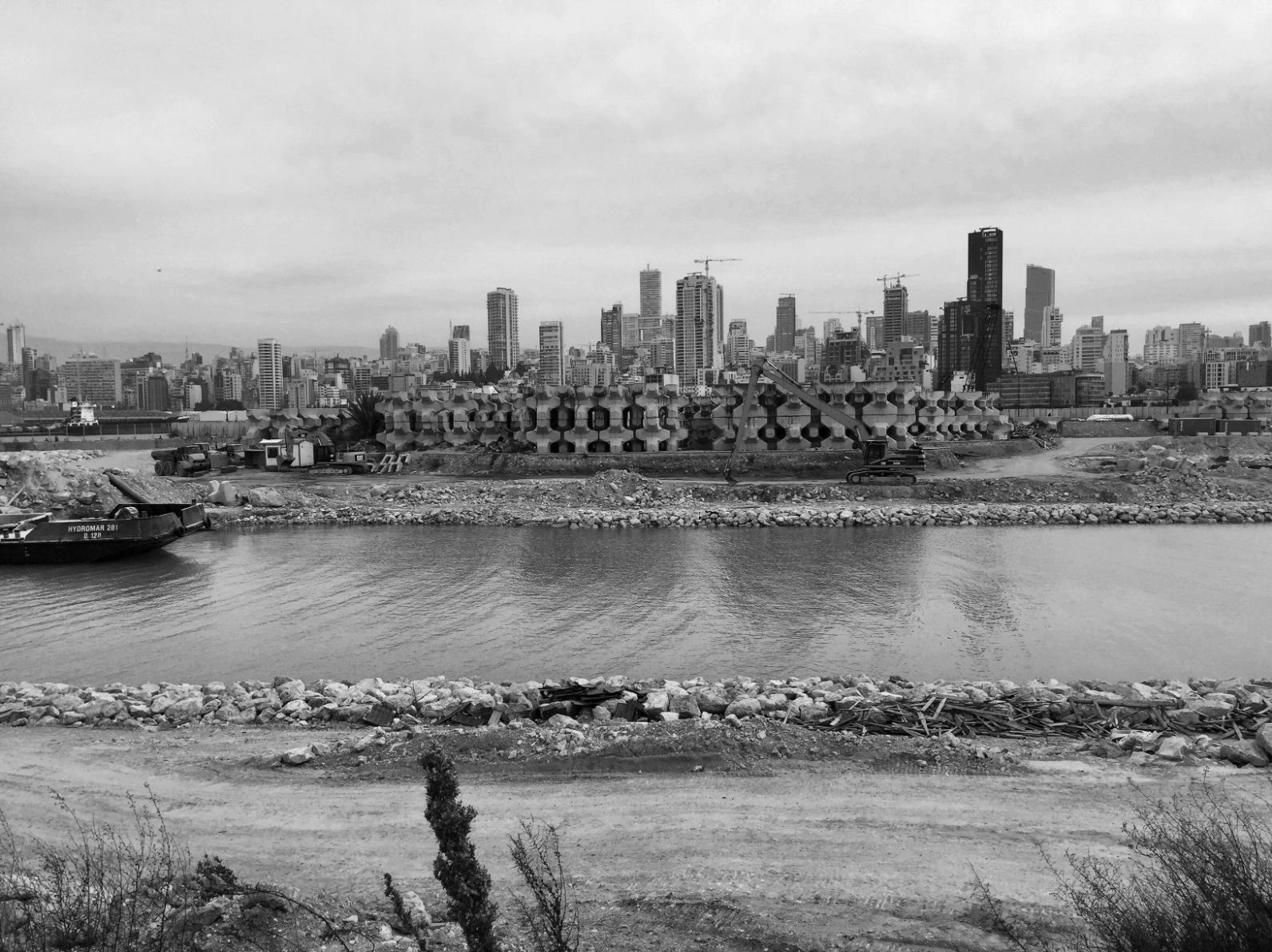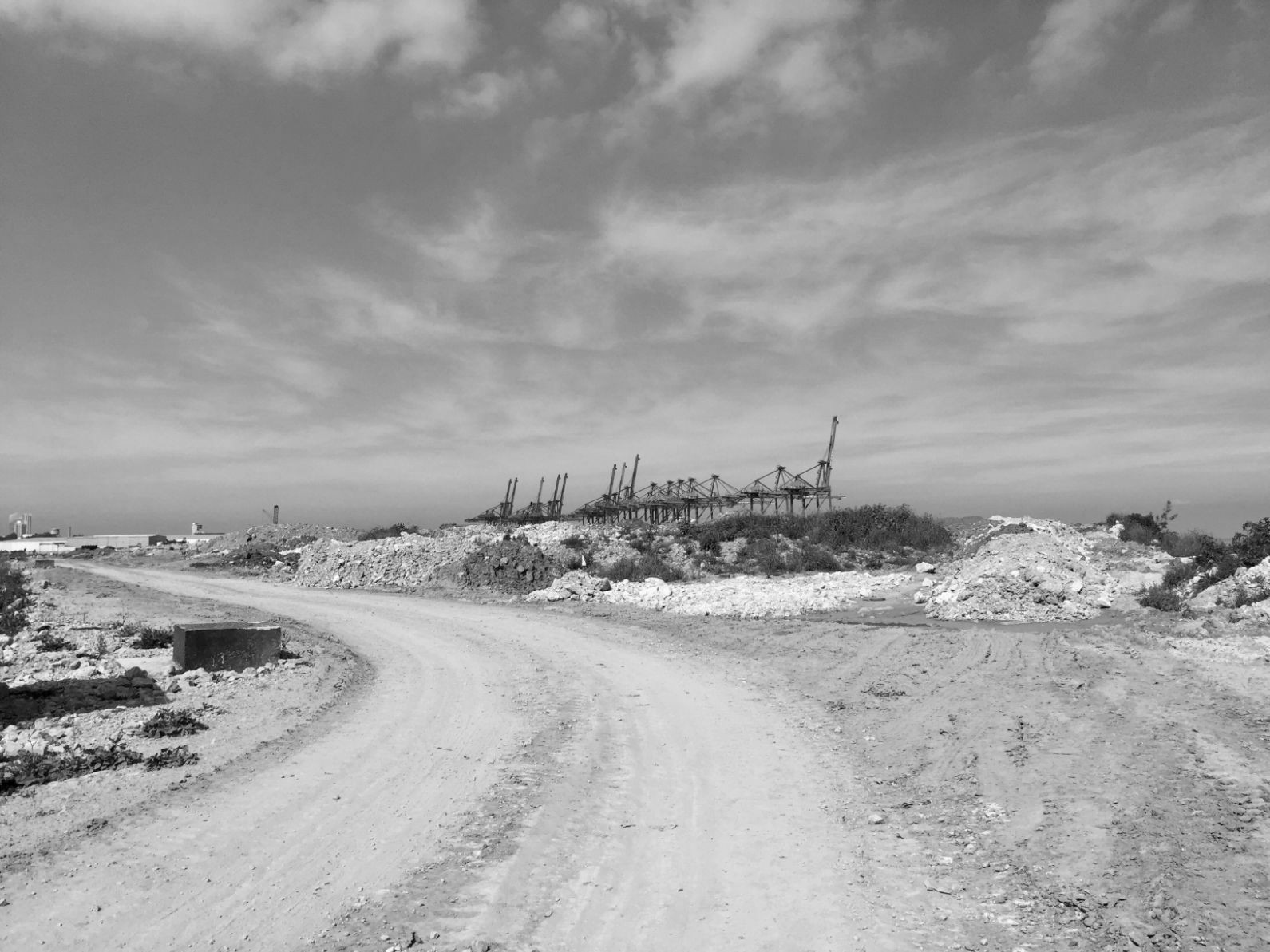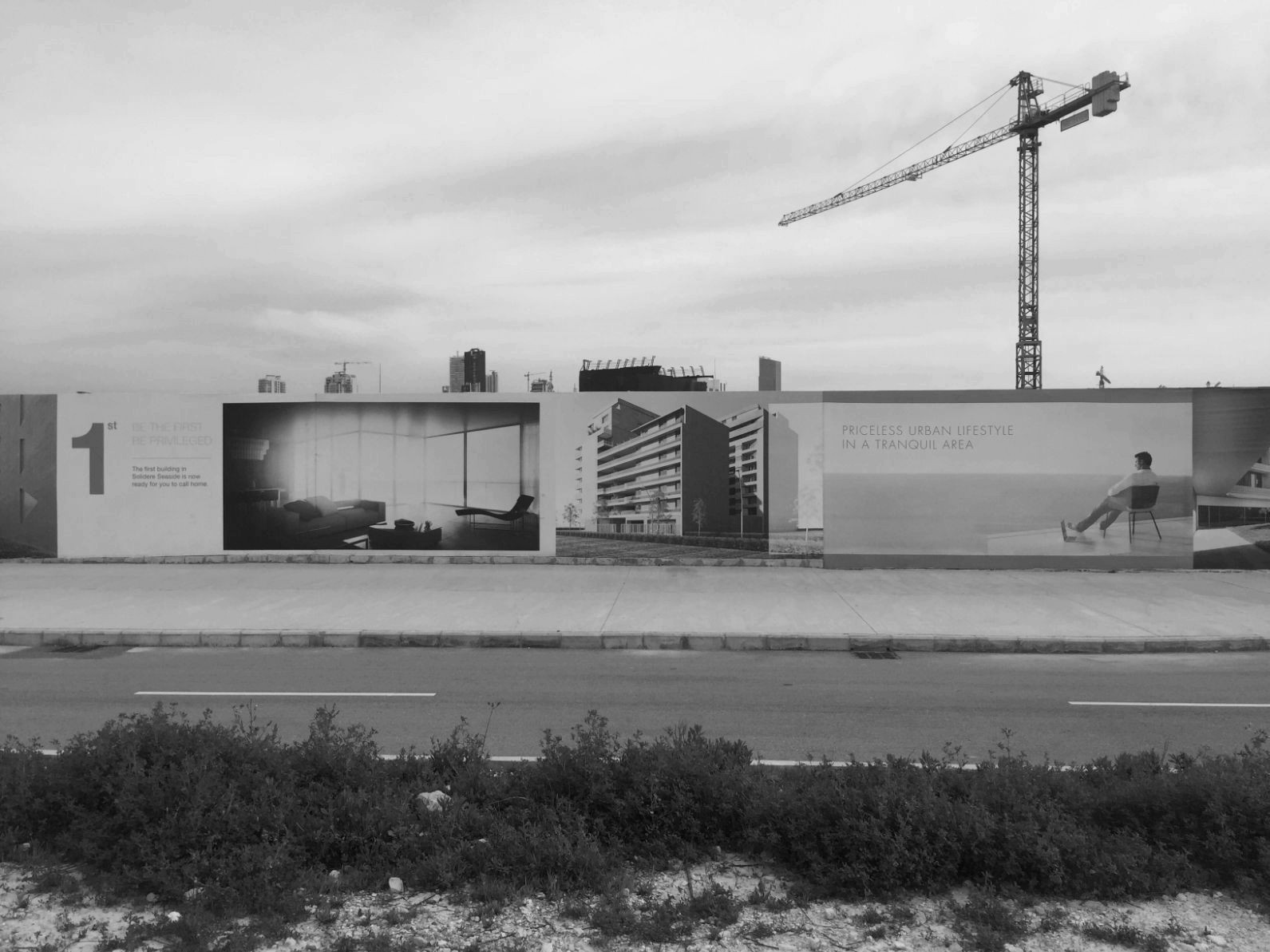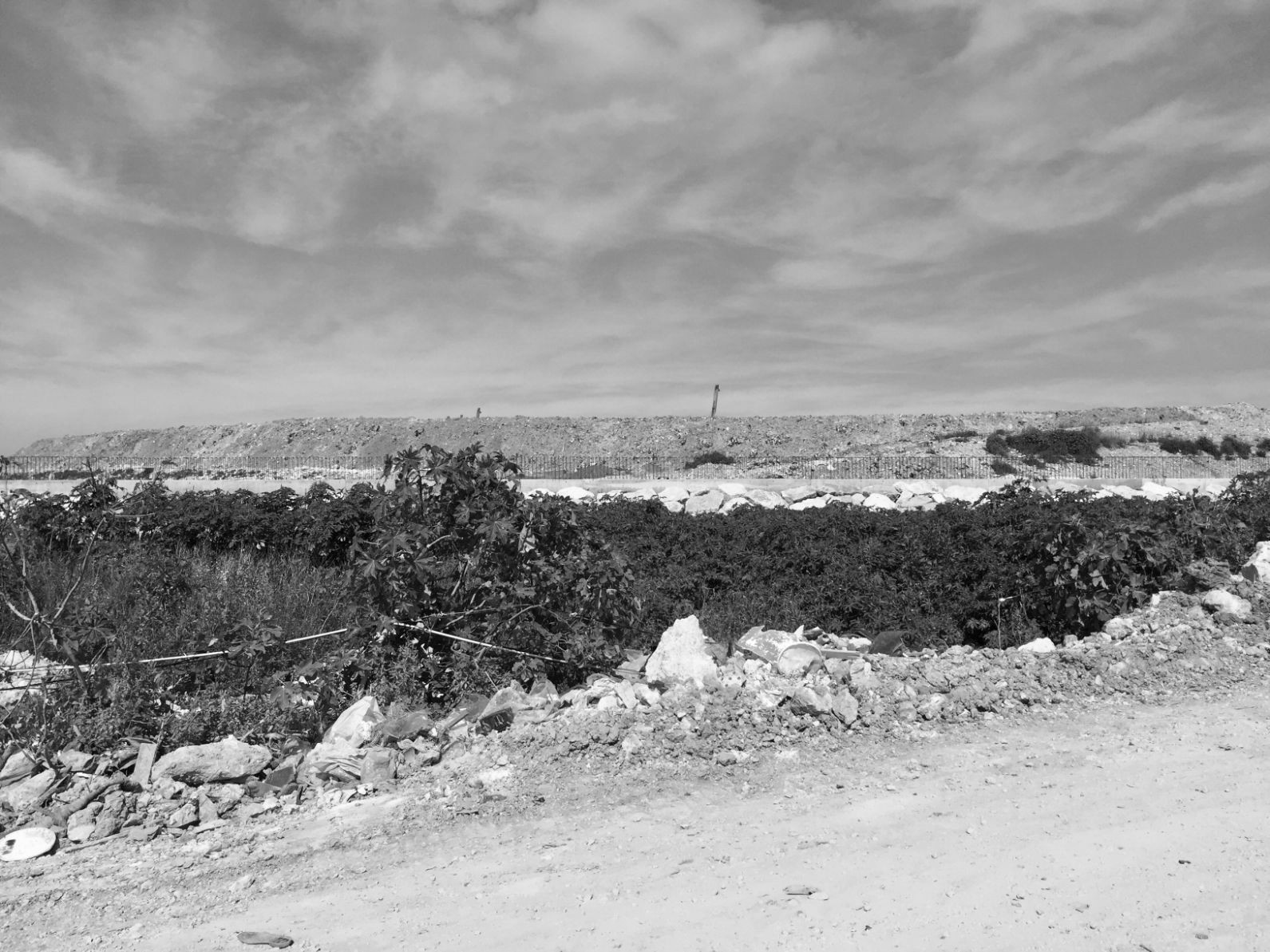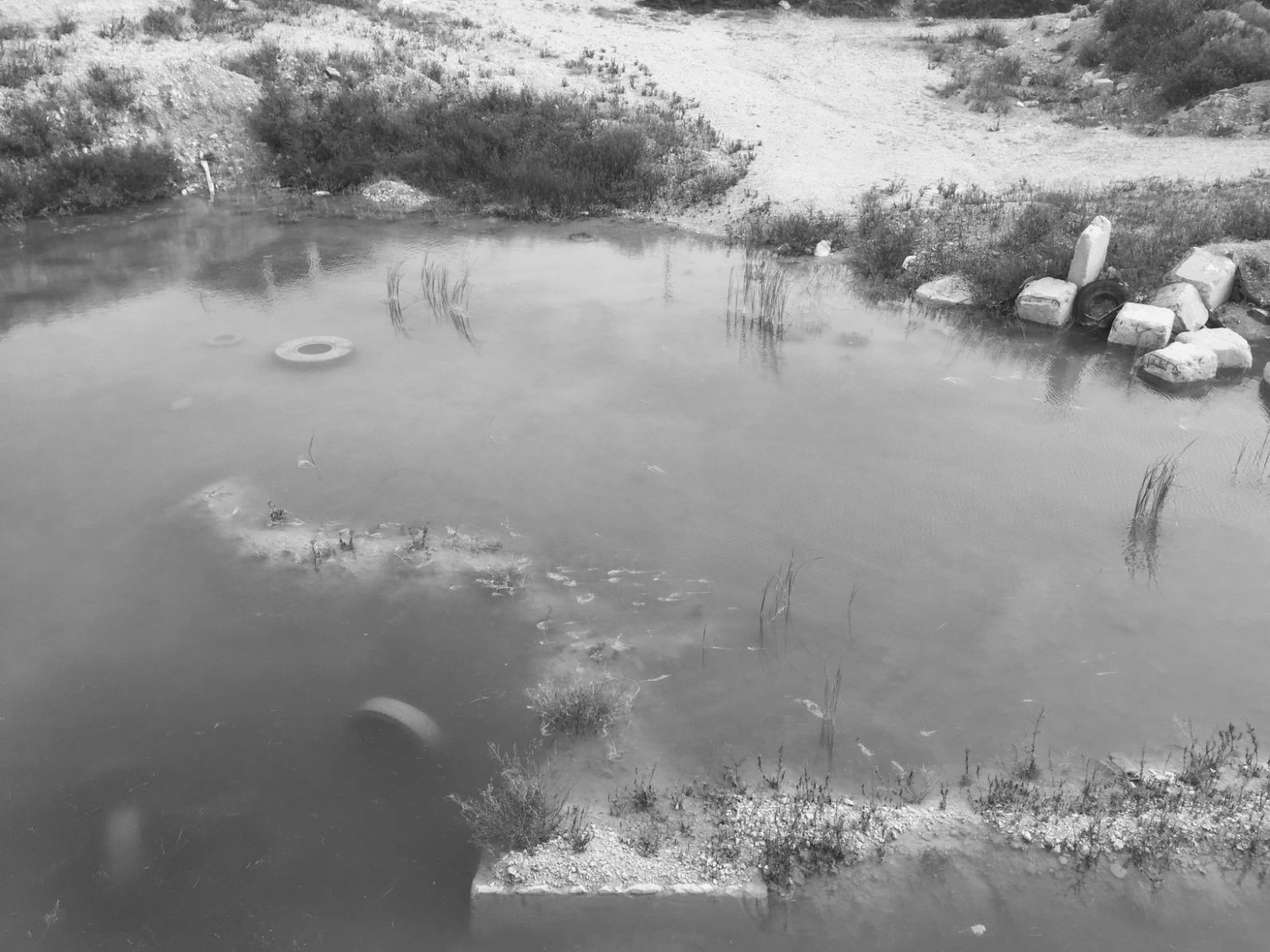The marina of Dawra
The marina has an air of peace and quietude. Gently, wooden boats sway at the pier. The sky is high and cirrus clouds form an unknown diagram. Fishermen clean their nets, even one or two yachts are rigged here. The air is sweet and slightly sticky, but the fresh sea breeze carries any unpleasant scents away, towards the city. If you do now know about it, you will not notice the army checkpoint at the exit of the small harbor. It is hidden behind boats.
To the left, there is a big, vacant plateau: an unspecific, yellow-brownish area of flatland around which a gravel road has been levelled. It is very large, but deserted. Only a few stray dogs jump around and some young men seem to look for scrap metal or recyclables. Behind the plateau, you can see the cranes of the container terminals at the port of Beirut.

None of this existed a few years ago. Where a large, undeveloped peninsula has now been created, there used to be water and waste. Not very long ago, a gigantic, almost 60-meter-high mountain of old, discarded things towered up here, its flanks sloping straight down into the Mediterranean. Several 100,000 tonnes of waste – everything from car tires, chemicals, household waste and construction waste, to old paint, computers, electronic appliances, children's toys and organic waste – were gradually removed and dumped into the sea. Waste has become new land.
Work continues on the opposite side of the marina. The procedure is not complicated: The waste is mixed with sand and building rubble and compressed. This mixture is filled into large white nylon bags, which are used to gradually fill the sea bed cell by cell. The work flows peacefully. Nobody seems to be interested in the secret alchemy that is going on here. Mountains are moved, land is taken from the sea, and money is made from waste.
On the way back from Dawra to Ashrafieh, Nour and I drink coffee in a street bar and look at all the biscuits and tarts that are individually wrapped in plastic. In one of the petrol stations at the beginning of Armenia Street a man wearing a white polo shirt and mirrored sunglasses cleans his Mercedes convertible with great devotion. In the evening, while taking a shower, I wonder about the ginger-scented soapy water that disappears in the spout, flows through pipes, and runs towards the ocean without being filtered.
For our joint research on land reclamation projects in Lebanon, Lebanese sound artist Nour Sokhon and I spoke with more than twenty activists, journalists, scientists and politicians in March and October 2019. Excerpts of the interviews are part of this report. Because their public expression of opinion might not be without danger in the context of Lebanese politics, not all of our interview partners are mentioned by name. However, some of them will appear as protagonists in the following. The research was conducted before the beginning of the social protests in October 2019 and before the massive explosion that hit Beirut in 2020. Some of it will therefore be outdated, yet we believe the topic is still of big importance.
Mar Mikhael, the nightlife district
If you walk from the marina of Dawra towards the city centre, past the war-torn houses next to the motorway, through the Armenian quarter Bourj Hammoud with its colorful clothes shops, past the best hummus shop in town, you will end up in the hip nightlife district of Beirut. It is less than a 20 minutes walk.
Mar Mikhael, and neighboring Gemmayzeh, are known as the centre of Beirut's nightlife. Walking down central Armenia Street or Rue Gouraud on a Friday night, you may get the impression that the most beautiful and exuberant young people of all seven continents have gathered here–princesses, princes, and kings of fragile, carefree existence. Beirut is known as a city with a fantastic nightlife, a city of bars and cigarettes. The Paris of the Arab world, the city that never sleeps, despite the civil war or any other catastrophe that might aggravate the lives of people.
In a backyard on Armenia Street you find the exhibition space called ‘Haven for Artists’, where I, on my first visit to Beirut, viewed an exhibition by Nour. I travelled to Beirut as a tourist for the first time in May 2018. On this first trip Nour and I met by chance. Whether it is destiny or simply intuition, on my first evening in the city, I ended up in a small, wood-panelled bar. The Citizen Smith is located in a side street of Hamra Main Road, in the very west of Beirut, where in the 1950s and 60s the intellectuals of the country and almost the entire Middle East met, smoked and discussed. At the counter, the only other guest, a Palestinian American, tells me about her life. Jihane came from Brooklyn and quit her job as an employee of a logistics company to go in search of her roots. Late in the night, Nour enters the bar together with afriend. She tells us about her exhibition which deals with plastic in the Mediterranean and noise pollution in Beirut and invites us to the opening. I went to the exhibition and continued the conversation there, from which, subsequently, this research emerged.
Lebanon is a country marked by extreme conflict and social inequality. It is built on a finely balanced system of power-sharing between confessional groups–Sunni and Shiite Muslims, Christians, Druze and a total of 14 other religious groups–which guarantees political positions to the individual sects. Since the civil war, this fragile balance has been the volatile ground on which the country was rebuilt. The fragmentation of the political landscape into confessional factions leads to heavy clientelism in which public positions and common goods are assigned and used according to group membership. In short, each power faction tries to steal from the state wherever possible. Young Lebanese therefore have the feeling that they are being held hostage by their own elites, who are constantly threatening, if subliminally, the return of civil war.
Architecturally, Beirut today has few explicit reminders of the civil war. Only those who pay attention will still find bullet holes on some walls. On the edge of the city centre, there is one such monument: a large, partly bombed-out hotel. The old Holiday Inn hotel was an epicenter of sniper activities. Only two years after its opening, which was marked by the tourism boom of the 60s and 70s, the skyscraper became a combat zone. Christian and Muslim militias were trying to conquer it. Later, it was looted and the furnishings, including silver spoons and knives, were sold on the streets of the city. After the war, it stood empty for a long time, there were summer parties in the cellar. Today, it is an army barrack full of graffiti, and politicians are arguing about what to do with the old hotel.

While the city glitters seductively at night, layers of dirt and trauma lurk underneath. It seems as if these traumas and secrets are guarded by dark towers somehow watching over the port in the distance – the towers of the new city centre.
Skyscrapers and fountains
In the new downtown area of Beirut, there are luxury skyscrapers with terraces full of fountains and little water parks. While everywhere else in the city, electricity lines hang over the streets in a chaotic meshowork, here you see perfectly plastered walls.


During the Lebanese civil war, the entire city centre, which before the war had been a point of hybridization for different religious and social groups, was destroyed. Today, one might be under the visual impression that the civil war never took place. Here, it looks like in Dubai, in Hamburg's HafenCity, or in Shanghai. The buildings, designed by star architects and financed with money from the oil sheikhs of Saudi Arabia, stand empty. Not a single light is lit at night because all the flats were bought as objects for financial speculation. Nobody lives here, the assets multiply on their own.
All the mirrored towers of this investment paradise, displaying their emptiness and an uninhabited state at night, are built on ruins. In order to manufacture the portrait of a functioning city, people were expropriated, history was erased, and waste was dumped into the sea.
BIEL
Leaving the glittering new city centre, you suddenly find yourself on another large, almost undeveloped peninsula. It is called BIEL (after a shopping and event centre) or Waterfront District. A security guard checks that you do not enter the promenade where construction works have apparently not been finished yet. Nobody walks here, two garbage men from Bangladesh collecting plastic bottles instead.
We try to find out who hired them, but don't get far. As we try to enter to the BIEL shopping center, Nour and me pretend to be a married couple who visit the city as tourist. My status as foreigner, and thus as someone who is not initiated to the layers of trauma and conflict that are present in many daily interactions, is helpful in that regard.


Leaving the glittering new city centre, you suddenly find yourself on another large, almost undeveloped peninsula. It is called BIEL (after a shopping and event centre) or Waterfront District. A security guard checks that you do not enter the promenade where construction works have apparently not been finished yet. Nobody walks here, except for two garbage men from Bangladesh collecting plastic bottles. This district was created after the Lebanese civil war. During the civil war, the ruins of the former Normandy Hotel became a dumpsite. When the war ended, the waste of the war was used as filling material for a gigantic land reclamation. The peninsula that was thus reclaimed from the Mediterranean up until 2006 is about 24,000 square kilometres in size. Initially, the peninsula was advertised as a city park, but today the plan is for luxury real estate to be developed here. Yet, up until today, no permanent constructions have been built. The question is, whether the waste and rubble that makes the ground here is stable. Are people afraid that the land will sink? Or has the property bubble burst?
Der Aktivist Mario Goraieb erzählt Nour und mir bei einem Interview, dass das Gelände von Landgewinnungs-Projekten langsam absackt. Er weist uns außerdem explizit darauf hin, dass der Prozess der Landgewinnung am Ort der ehemaligen Normandy-Deponie weitgehend ungeregelt und ohne Umweltmanagement vor sich ging. Lastwagen voller Müll haben ihre Ladung einfach ins Meer geworfen.
I imagine that, one day, an excavation site would be created on the peninsula of the Waterfront District. Under the rubble of skyscrapers you would then find the compacted waste, and future researchers could read our lifestyle from our discarded everyday products as if from an oracle.They would probably wonder who initiated the great burial and revaluation of the waste. It is former Lebanese Prime Minister Rafiq Hariri. The luxury flats and the peninsula created from the waste are the monumental work of this adopted prince.
There is a number of alternative ideas of how to use the BIEL peninsula, some of them artistic. Cf. for example the project Beirut Field by Frederic Karam and Jan Ackenhausen.
Citizen Hariri / SOLIDERE
Rafiq Hariri, who was Prime Minister of Lebanon from 1992 to 1998 and from 2000 to 2004, is an important link between Lebanon and Saudi Arabia. In the 70s and 80s he became rich there as a construction manager. During this time, close contacts with the Saudi royal family were established, Hariri was granted Saudi citizenship and he was appointed as the country's ambassador to Lebanon.
Our knowledge about Rafiq Hariri is from the book Citizen Hariri by German sociologist Hannes Baumann. In a telephone conversation, Baumann also points to the parallels between the reconstruction of Beirut after the civil war and other neoliberal urban projects such as the HafenCity in Hamburg or Docklands in London. All of these urban megaprojects aim at opening the city to international capital. Political influence and control, Baumann argues, is crucial to these policies, contrary to what they themselves claim.

In 1989, after the end of the Lebanese civil war, he returned to his home country and became president. Hariri is considered the architect of the Ta'if agreement that ended the civil war. In the following years, with the help of major Saudi shareholders and parts of the Lebanese diaspora, he founded the half-private construction company SOLIDERE which was tasked with managing the reconstruction of Beirut's inner city.
As a construction company operating under private law, while at the same time being firmly in the hands of the Prime Minister, SOLIDERE organized the expropriation of the remaining population, the demolition of buildings, some of which were only slightly damaged, and the acquisition of international capital. The entire city centre was razed to the ground and a glittering new showcase Beirut built. Voices from civil society accuse the oligarch, who is friends with the Clintons, among others, of having benefited considerably from the reconstruction himself. In the vernacular, the city centre is therefore simply called 'Hariri City'.

The peninsula and the towers were constructed as a monumental sign signifying that trade and international investment was again welcome in Beirut. The slogan of the reconstruction, as journalist Timor Azhari reminds me, was: “Beirut - An ancient city for the future.”
Old and new silkroads
From the BIEL peninsula we try to walk into the port which is located directly to the East. As one of the ten largest seaports in the Mediterranean, now run by a Franco-Lebanese company, the Gestion et Exploitation du Port de Beyrouth, the port of Beirut is considered to be the gateway to the Middle East. In ancient times, and even before that, Lebanon and the entire Levant was an important trading region, linking Eastern and Far Eastern markets to the Mediterranean. From here, the Phoenicians, whose main ports were Beirut and Tyre, controlled trade routes as far as to Gibraltar and beyond into the Atlantic Ocean. As important intermediaries between East and West, the people living here were part of the ancient Silk Road.
The famous Lebanese politician wrote the following about Beirut and Tyre: We must remember that Tyre in ancient times served as the principal world seaport, longer than any other seaport in history - longer than Venice, longer than London, longer even than New York; and while Beirut cannot aspire to break that unique record, or even approach it, there does appear to be something about these shores, something about these clement mountains, and something about the age-old world-openness of the Lebanese that would make us expect some continuation of a world function: the international exchange of goods and ideas coming from the Mediterranean, and Beirut appears to be the natural candidate for that function.
Later, the French colonial masters exploited the Lebanese silk production. Today, the Chinese want to build a large container terminal in Tripoli to connect Lebanon to their ‘New Silk Road’. While the Levant used to be at the centre of widely ramified trade routes, Lebanon is now under great economic and political stress. The country is heavily in debt, and many local powers (especially Saudi Arabia and Iran) and the global adversaries USA and China are trying to secure their influence.
Of course, we are not allowed to enter the container port. It is, as everywhere else in the world, a high-security zone, which is only accessible with special permission from the authorities. We watch the choreography of containers from the roof of a bar in Gemmayzeh. While one might easily guess that electrical appliances or spare parts from Germany are unloaded here, almost nobody knows that toxic waste from Germany is built into the concrete plateaus of the port:
Toxic waste, the Italian mafia and the port as grave
In the late 1980s, European and German industrial companies, especially in the chemical industry, were forced to implement new environmental regulations. No longer were they allowed to simply discharge toxic waste into major German rivers, such as the Rhine. The new recycling processes they had to implement were expensive and lengthy. For this reason, several German companies simply sold their toxic chemicals (old paints, old varnishes, chemical liquids, oils and batteries) to the Italian Mafia.
At the end of the 1980s, the Italian mafia thus began to play a major role within the international illegal trade of waste. Innumerable shiploads of toxic waste were transported to North Africa, the Middle East and Lebanon. The Christian soldiers, who at that time during the civil war were still controlling the port, accepted several shiploads of toxic waste. In return, they got remunerated for discarding it.
Only after I return to Hamburg, I meet someone, who is able to tell me more about the extension of the port and the toxic waste from Germany that is stored there. He wants to stay anonymous.

When a Greenpeace campaign made the trade in toxic waste public, many of the hundreds of barrels that had arrived in Lebanon were already scattered on various wild landfills across the country. While Italy was forced to take back parts of the cargo, some of the toxic waste, according to serious Lebanese media, including the 'Daily Star of Lebanon', was used for constructing and thus buried in the extension of the Beirut port in 2006.

It is the same port that was hit by an extremely massive explosion on August 4, 2020. The detonation of nearly 3000 tons of Ammonium-Chloride destroyed large parts of the city of Beirut. Mar Mikhael and Gemmayzeh, where Nour and me had met most of our interview partners, were hit especially hard.
The headquarters of the Christian soldiers, who administered the waste import, was located directly at the port next to the large landfill and waste incinerator of Karantina. As some informants suggest, bodies might have been disposed of at the landfill during the war. The concrete plateaus of the port extension, which today serve as container terminals, one can speculate, might thus also contain human ashes.
More than any other container port, this port is a grave. It is a grave in almost a threefold sense: Firstly, in so far as there literally are burnt corpses built into the concrete foundations of the port extension, secondly, because of the massive bomb that would explode in the port later on, in August 2020, and, finally, because the port is one of the major symbols of the corruption and informal networks that govern Lebanon and that make life difficult for its citizens on a daily basis. Only the third point, I guess, may apply to other ports around the globe as well.
Infrastructure Agencies
Large infrastructure projects, such as the expansion of the port of Beirut or the land reclamation project of the Waterfront District , cannot do without technical advice. The specialized consulting firms operating here are the secret agents of globalization, connecting ever new places to the world market via large infrastructure facilities.

In the case of the port extension in Beirut, the large Lebanese company Dar-El-Handasah, which advises infrastructure and construction projects around the world, is said to be involved. Since 2007, the Hamburg-based company Sellhorn has also been on the project. I cannot find out, whether and to what extent the company is aware of the fact that toxic waste was used in the project. Indeed, the knowledge managers of globalization often disguise themselves as technocrats. Apparently, they are always only ever responsible for the technical implementation of logistical mega-projects.
Note after a conversation with Mr. Leger of Hamburg-based company Sellhorn on March, 18, 2019 at 2.30 pm:
> the company Sellhorn has been working on the extension of port from 2007-2017, i.e. planning, supervising and implementing the further extension of the port for the ‘Gestion et Exploitation du Port de Beyrouth’
> the extension of the port was done by using rumble, i.e. construction material, that is dumped into the water layer by layer, it cannot be organic material, my conversation partner asserts that in their case, only non-organic material was being used but he believes that accusations might be true that other, toxic or dangerous materials might have been used in earlier extensions of the port, even if he cannot be sure about them
> another severe problem is the soft underground (under water) close to the so called Beirut river, the place where the wastewater is being released to the sea, therefore it has been difficult to extend the so called break-water to the east
All the while, there is many people in Lebanon who are trying to use waste as infrastructure in quiet a different way, by not just by dumping it into the sea, pouring it into concrete, making it invisible, or making it disappear.
The king of recycling
During our joint research in Lebanon, Nour and I met various recycling initiatives in Lebanon. None of them are governmental, all are based on the initiative of private individuals or NGOs. The social entrepreneur Ziad Abi Chaker, for example, who the Lebanese media sometimes call the 'king of recycling', has built a number of recycling factories throughout the country. As an engineer, he also develops various products made from inert waste himself, including soft plastic fibres, hard-plastic beams and paper-boards.
Two different strategies for dealing with waste face each other here: Either the waste is buried in the sea and thus becomes the volatile ground on which to build new skyscrapers, or it is transformed into recyclable materials that can be used for construction, as well. These construction are perhaps less massive, but more sustainable.
When Nour and I visited him, Abi Chaker was sitting in front of a large flat screen mounted on the wall. While he tells us about his work in a deep voice, he constantly follows his social media feed. He seems like an independent warrior - one that fights for a good cause, that of recycling.
Joslin Kehdy
Joslin Kehdy is an environmental activist and founder of the first zero waste shop in the Middle East: the Eko-Souk, which Joslin runs together with Nariman, is located in the West of the city, not far from Hamra Main Road. Joslin and Nariman refer to their shop as a hub for circular economy. 'Hub' is also the Arabic word for love.
Joslin has brown hair, she wears roundish silver glasses, and speaks with impressive conviction. Again and again, she organizes activist campaigns in which, for example, beaches are cleaned from plastic. At the same time, she collaborates with various local producers who are reviving old manufacturing techniques and processes for the production of clothing, cosmetics and other consumer goods.
Joslin explains, how waste has become an issue in Lebanon. Since the Lebanese civil war, she says, waste management has been neglected, and only a fraction of the waste is recycled. At the same time, the people in the Levant actually know a number of old techniques which are designed for the sustainable and efficient use of food and consumer goods. These old cultural techniques have only been lost as part of a Western lifestyle. Joslin therefore demands that imported concepts and solutions will no longer be applied to problems that have only been created by Western consumer behavior. The West has to stop fucking us up, she tells Nour and me in an interview.
EU sewage plants and the Declaration of Barcelona
One example of misguided Western commitment to overcoming the waste crisis in Lebanon are the sewage plants. A total of four of these expensive plants were built with EU funds to treat Lebanese sewage. None of them is operational. While the EU provides the money for construction, no money is spent on connecting the plants to the local sewage system. The EU sewage plants thus resemble the infamous parliamentary tents that George Bush wanted to drop onto Iraq during his war against Saddam Hussein. They are 'well-meant' ideas that are dropped from the air by higher powers, but not compatible with the respective local reality.
The EU is also failing to enforce its own environmental standards. The lack of waste water management in Lebanon is severely affecting the water quality of the Mediterranean Sea. The Barcelona Declaration, signed in 1995 by all littoral states of the Mediterranean, proclaims effective environmental protection. Lebanon, however, is not publicly accused by the EU for its ongoing environmental crimes. Too many Syrian refugees live in the small country, so that Europe is afraid they might be send towards the North. As the EU is dependent on the small country, its own supposedly high environmental standards are simply forgotten.
The waste mountain of Bourj Hammoud
Often, an invisible cloud of egg-smelling gas hovers over the Eastern quarters of the city. It is sulphur monoxide, a poisonous gas that causes respiratory diseases and cancer. The gas is carried up from the coast to the Eastern residential neighborhoods of Beirut. There, at the marina of Dawra, is where the large waste mountain of Bourj Hammoud, an old landfill that was used illegally during the civil war, used to stand. The landfill was closed in 1997 due to extreme overuse, but had to be reopened as an emergency measure during the waste crisis of 2016.

The garbage mountain was so large that at times it overlooked the entire neighborhood. Again and again, it self-ignited because of the flammable gases that were generated on its inside. Environmental scientists estimate that every year some 120,000 tonnes of toxic waste water seeped into the Mediterranean Sea. And even today–after its conversion into a land reclamation–increased sulphur monoxide levels are regularly detected in Bourj Hammoud by the Nature Conservation Center of the American University of Beirut.
The Lebanese artist Fadi Mansour has dealt extensively with the practice of land reclamation in Bourj Hammoud. Results of his research are a film and the following essay.
The alchemy of waste
For several years now, the waste mountain has been gradually removed and used as filling material for a large land reclamation project, just like the Normandy landfill was used for the expansion of Beirut's inner city. The project is called 'Linord' and its conception dates back to the last years of the civil war.
For the land reclamation, the waste is neither processed nor separated. Recyclables are not sorted, only large metal parts are removed. The waste is pressed and packed in large white nylon bags, which are stacked on the seabed like large bricks. In order to slowly displace the seawater, first, a concrete dam is built at some distance from the old coastline, which–after completion of the land expansion–will represent the new coastline. In the case of the Bourj Hammoud land reclamation, there was serious problems when building the dam as so much waste had been dumped into the sea already, its bed was soft like butter.
It is unclear what the environmental impact of these land reclamations on the basis of waste is. What is clear, however, is that corrupt elites, in collaboration with infrastructure agencies, are making enormous profits here. It is a form of dark alchemy, an alchemic process in which waste is turned into gold:
Private companies, in association with powerful politicians, charge a high price for waste disposal and management, but do not handle it according to common standards. In a second step, the community pays for new land to be gained from this waste. Finally, the land can be sold. This is lucrative, as prices per square meter in Beirut have been the highest around the Mediterranean. Here, as in BIEL, developpers want to build high-rise buildings and sell them to international investors.
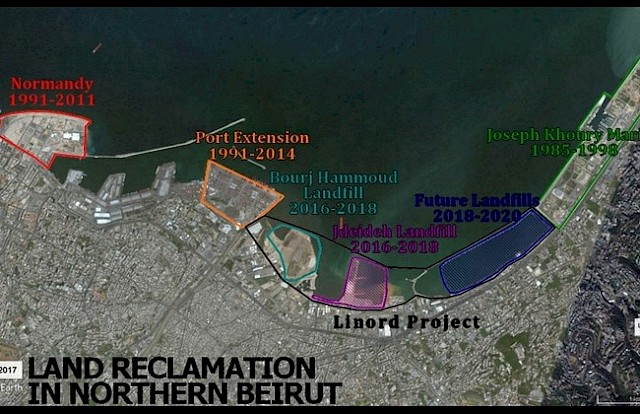
All the while, the population suffers: Their waste is badly managed, not separated and treated. The waste mountains on the Lebanese coast severely impact the quality of life in surrounding districts. The Mediterranean Sea is strongly polluted and water quality deteriorates. This alchemy of waste is a form of 'manufactured collapse', a perfidious way of capitalizing on poor infrastructure.
Manufactured Collapse
In one of our conversations, environmental activist Sammy Kayed of the Nature Conservation Center of the American University in Beirut developed the concept of 'Manufactured Collapse' spontaneously: For him, it is a description of how the climate catastrophe advances. He points out how the ongoing destruction of our planet concurrenty creates ever more social injustice. While very few people earn a lot of money from current and future catastrophes, many people are already suffering today and will suffer to a far greater extent in the future. As an example, Sammy speaks about the illegal export of old, dysfunctional electrical appliances to Ghana. Is a relatively inexpensive way for European countries to get rid of old materials that are expensive to recycled. The practice has therefore been tolerated for a long time by European governments.
Eine andere Spielart dieser Kapitalisierung von schlechter öffentlicher Infrastruktur ist das Loch von Onitsha.

Land reclamation on the basis of waste can also be described as a form of 'Manufactured collapse'. Economic and political elites make a lot of money by deliberately mismanaging common goods and public infrastructure–in this case: waste, public land and the sea–while privatizing profits. This is taking place, evidently, under the eyes of Western governments.
Nobody ever asks the people about their opinion. They suffer from the stench, the lack of electricity, and bad roads. They can no longer bathe on their own beaches, the water from the tap is too dirty for them to wash their hands or cook with it. The Lebanese political elite is jetting around the world, while regular citizens are subject to strict entry regulations into the EU or the USA. And that is why the people have had enough:
Thawra
The Thawra is initially fuelled by anger at increased cost of living, poor environmental management of nationwide fires in autumn 2019, and the introduction of new taxes on cigarettes and whatsapp phone calls. However, it quickly becomes clear that the Lebanese–who, for the first time, are protesting across religious borders in large numbers– are dissatisfied with their whole political class. In the country, which has been ruled by former war-lords since the Ta'if agreement, based on a complex distribution of power between the various religious sects, the political elite is plundering the state.
From 17 October 2019 up until mid-March–the beginning of the Corona crisis–Lebanese citizens take to the the streets in large numbers every day. After only a few days, Prime Minister Saad Hariri, son of Rafiq Hariri, resigns. But that is not enough for the Lebanese people: They demand the resignation of the entire political class and political independence from foreign influences, especially from Iran, Saudi Arabia, France and the USA. The lack of infrastructure is repeatedly cited as a major cause of the struggle. People are sick of dealing with poor electricity, poor and expensive health care, poor roads, and, last but not least, the lack of waste management.
It is as if a red line has been crossed here. In a country where not only the regional powers Saudi Arabia and Iran, but also the former colonial power of France, the USA and China are pulling at each other, where confessional affiliations are politicized, so that a small elite can enrich itself with the support of the international community. The 2015 ‘You Stink’ movement, which erupted over waste mismanagement issues, was an important precursor to the 2019 protests. Even if today not only waste, but the whole system is in question.
As a foreigner, I leave the country on Saturday, October 19, 2019, only two days after the protests have started. Nour and her fellow citizens are fighting for their rights. While I am in solidarity with their struggle, my privilege is very clear to me: I can leave whenever I want.
In particular, mobility is also a very unevenly distributed good in Lebanon. While many elites have international passports and therefore cross borders easily, it is difficult for Lebanese* to obtain an entry permit or visa for the EU or the US. The procedure is complex.
Paradise Lost
Today, almost a year after the conclusion of our research, the social, environmental and political situation in Lebanon is much more serious still than it used to be in October 2019. The protests have continued into the summer, despite the restrictions imposed by Corona. In addition to the already difficult situation, the country has been hit by a severe economic crisis since from spring 2020 onwards. The currency, the Lebanese pound, is rapidly losing value. In turn, savings and pensions that have been built up over several generations, are no longer worth anything. The banks keep assets for fear of capital flight. Many people find it increasingly difficult to afford food to survive.
On August 4, 2020, there is a huge, historically unparalleled explosion in the port of Beirut. Almost 3,000 tonnes of ammonium chloride, stored in a silo at the port–about a kilometer West of the port extension, where other waste is buried–explode. The highly dangerous material has been stored at the port for several years already without being secured. It can be assumed safely that the entire political cass was informed about the looming danger all throughout the years, right up to the President. Because of the explosion more than 200 hundred people die, thousands are injured, up to 500,000 are made homeless.
The state remains inactive. It is the civil society and private initiatives that clean the city, slowly begin to reconstruct buildings and secure the supply of the population. On Instagram I read the same sentence over and over again: We are hostages of a political class that is trying to kill us. Many Lebanese feel locked up in their own country. While it resembles a paradise – the high, snow-covered peaks of Mount Lebanon rise up right from the warm, Mediterranean sea, behind the mountain range lies the fertile Bekaa plain, where agriculture has been practiced for thousands of years – the country and its people, under the eyes of Western governments, are plundered by a crew of former war criminals turned turbo capitalists. The explosion is of their making.
Istanbul Airport
At the airport in Istanbul everything is clean and tidy. The floor tiles are mirror-smooth, the shop windows cleaned, the air cooled and filtered. Manically, I read the news about the ongoing protests, interrupted only by occasional announcements in which a female voice seems to connect different places on the planet to an ancient Greek mythical character. Pegasus Airlines flies to Tibilissi, Tehran or Moscow, and at least 150 other cities. The near total mobility seems absurd.
I ask myself how much waste my own travels to Lebanon have produced, what significance Western media and artistic research have for this context in general, and why so little is known about the routes and paths of our own waste. It seems that people prefer to ship it in darkness, away from the eyes of the public, because it stinks. Yet, it could be the cause for a revolution, not only in Lebanon.

As I breathe in the cool airport air, I am reminded of Sammy Kayed again. He told about a new Chinese car model. It's expensive–Sammy says, maybe $100,000–but equipped with the very best air filters, so that you can drive from your home that has filters to your workplace that has filters and never be exposed to the extreme air pollution of large Chinese cities.
Während ich mit der Wut der Libanes*innen solidarisch bin, frage ich mich nach meiner eigenen emotionalen Position, und finde sie in einem Text, den mir wiederum Sammy empfohlen hat: In dem Text Deep Adaptation: A Map for Navigating Climate Tragedy vertritt der Umweltwissenschaftler Jem Bendell die These, dass schwere soziale und politische Verwerfungen auf Grund der fortlaufenden Umweltzerstörung und Klimakrise nicht nur im Libanon, sondern überall auf der Welt mit großer Wahrscheinlichkeit unumgänglich sind.
Während viele seiner Kolleg*innen diese bittere Wahrheit aus institutionellen, strategischen oder persönlichen Gründen lieber nicht offensiv vertreten – auch weil sie nicht als Verbreitende von Hoffnungslosigkeit kritisiert werden wollen – ist Bendell der Auffassung, dass es an der Zeit sei, sich auf den Kollaps unserer Gesellschaften, wie wir sie heute kennen, einzustellen und vorzubereiten. Dabei skizziert Bendell für sein Programm der 'Deep Adaptation' drei Schritte:
Der Begriff der Resilienz fragt danach, wie wir das, was wir brauchen und lieben, erhalten können. Der Begriff des Verzichts (im Englischen: relinquishment) stellt uns die Frage, was wir aufzugeben bereit sind, um die Situation nicht zu verschlimmern. Und ein Versuch der Erneuerung (im Englischen: restoration) stellt uns vor die Aufgabe, Strategien zu entwickeln, um mit zukünftigen Krisen besser umgehen zu können.
Bendells Programm der kollektiven Trauer spricht dabei Jede*n von uns an: By that I mean the implication is for you to take a time to step back, to consider 'what if' the analysis in these pages is true, to allow yourself to grieve, and to overcome enough of the typical fears we all have, to find meaning in new ways of being and acting.
The borders between those who can protect themselves and those who are exposed to the ongoing destruction of our planet and exploitation of common goods are multiplying invisibly. Today, protection and exposure are constantly being renegotiated in every place and at every time. The walls of paradise are invisible and porous, they can be fortified only with capital and privileges. The question is, how much longer?


